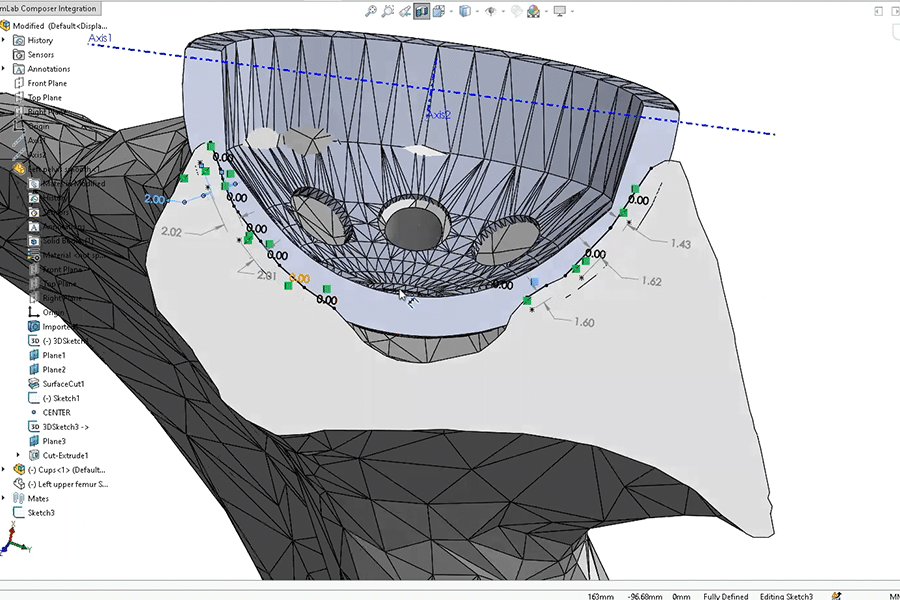Personalized surgical guides have now been used in a sample of mainstream robotic-assisted procedures further supporting the advantages of personalized joint replacement techniques and preoperative planning.
Robotic-assisted surgery has been around for over a decade now and is used in many various surgical applications, including knee and hip arthroplasty. There does tend to be a slight misconception from a patient standpoint about the differences between a robotic-assisted joint replacement and a standard joint replacement. When many people hear the phrase “robotic-assisted” it’s quite common to immediately think “better”. The two are actually more similar than one might think. One advantage to robotic-assisted surgery is that the software driving the robot has pre-positioned guides for the robot to operate in; think of bumpers at a bowling alley. This helps to minimize the margin of error and may help reduce the rate of infection even though total joint replacement procedures are considered very safe and routine already. That being said, the only major difference between a robotic-assisted total joint replacement and a standard joint replacement is the robot. Both procedures aim to deliver a mechanical alignment total hip or total knee replacement, otherwise known as a one-size-fits-all approach.
Now that there is a steady stream of evidence supporting more personalized methods for knee and hip arthroplasty, a group of researchers set out to determine whether or not personalized cup guides for robotic-assisted total hip arthroplasty would result in better functional outcomes as well as reduce the risk for posterior dislocation. To do this, they compared the one-size-fits-all, mechanical alignment guide, with three varying personalized guides, the acetabular rim labrum guide (ARLG), transverse acetabular ligament guide (TALG), and ischiatic-pubis line guide (IPLG).
The researchers establish that “preoperative planning is the most important step in robotic assisted [total hip arthroplasty] THA to determine the accuracy of components.” The preoperative planning used in robotic-assisted procedures uses the exact same techniques as Kinomatic for our Custom Surgical Plans. That is by using CT imaging to recreate the pelvis and both hip joints in a 3D space. The procedure is then planned out in the computer software to determine the optimal cup and stem positioning. However, as we have established, mainstream robotic-assisted systems such as MAKO and ROBODOC use mechanical alignment, one-size-fits-all, guides for cup positioning resulting in potentially controversial ‘optimal’ positioning. Kinomatic differs from this method by employing truly personalized measurements and positioning of the implant components specific to the patient’s anatomy.
What the study concluded is that all three of the personalized guides resulted in larger flexion and internal rotation than their mechanical alignment counterpart. This is significant for improving hip range of motion and decreasing the risk of posterior dislocation. This study does a great job of highlighting two things: one being how truly important the preoperative planning step is before a total hip replacement (and we’ll extend that to any joint replacement procedure); and two, how transitioning to personalized surgical plans, whether the surgical technique involves a robot or not, can improve key factors leading to improved postoperative quality of life.
If you’d like to learn more about how Kinomatic is personalizing total joint replacement procedures for improved patient outcomes click here.
To read the full article this post references, click here.
Article Citation:
AUTHOR=Wang Ruoyu, Zheng Xiaojing, Xu Tianze, Gong Song, Liu Shaokai, Han Lizhi, Yang Shuhua, Xu Weihua
TITLE=Personalized Cup Positioning Guides Improved Cup Positioning and Hip Ranges of Motion in Robotic Assisted Total Hip Arthroplasty
JOURNAL=Frontiers in Bioengineering and Biotechnology
VOLUME=8
YEAR=2020
URL=https://www.frontiersin.org/article/10.3389/fbioe.2020.00988
DOI=10.3389/fbioe.2020.00988
ISSN=2296-4185
